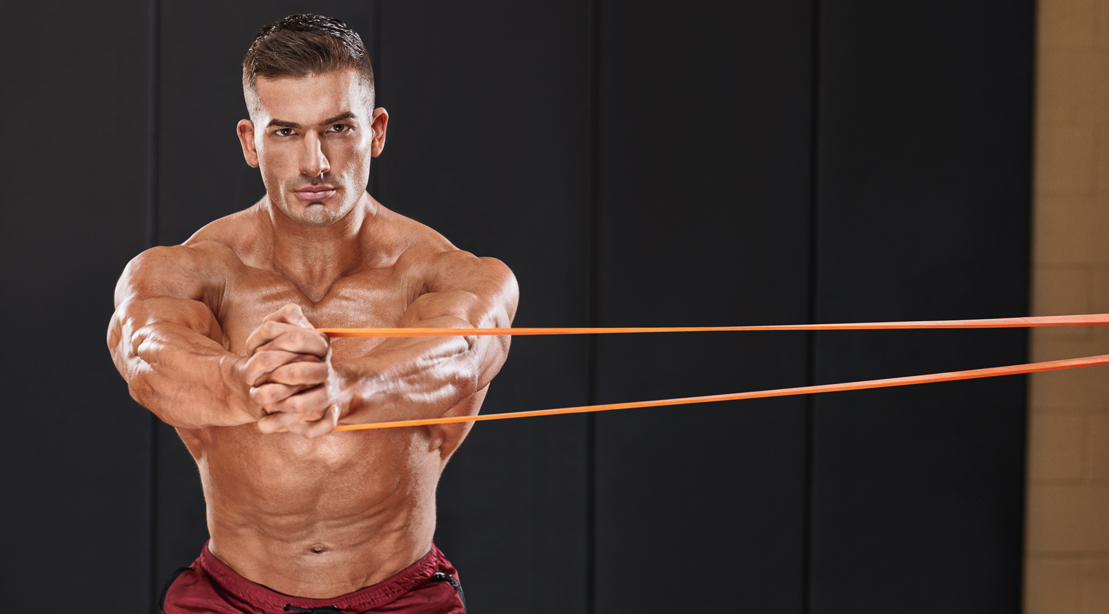Sometimes small things pack a surprising punch. And that pretty much sums up resistance band workouts. The color-coded, portable equipment used to be the most undervalued tool in the gym, often reserved for a physical therapist or the older crowd. That is not the case today.
Resistance bands made a serious impact on fitness enthusiasts during the pandemic, and continue to climb in popularity, with the market expected to reach 1.62 billion dollars by 2025.
After all, they’re versatile, affordable, and can provide an unexpectedly intense workout.
But just like all other fitness equipment, there are pros and cons, (we’ve all had bands bunch up and become a twisted knot during a workout). Here, Daniel Saltos, aka Train with Danny, NASM- certified personal trainer and fitness influencer, covers the pros and cons of using resistance bands and provides three incredible band workouts you can do anywhere.
The Pros To Resistance Band Workouts
When compared to free weights, bands have become a crowd favorite. “Since bands are space-saving, portable, affordable, and fun, they appeal to much more of the general population,” Saltos says. They also give everyone the ability to work out anywhere at any time, without lugging around heavy equipment. “Supplying many benefits to the body, working out with bands improves flexibility, increased strength, and is great for injury prevention,” Saltos explains.
While resistance bands are physically working against you, they’re actually working for you in the injury prevention department lessening the load on joints and tendons.
And if you’re looking for greater muscle stimulus, bands are the way to go. Training with bands provides greater muscle stimulus delivering the full range of motion through the entire exercise. As with free weights, there are parts of the exercise where the muscles aren’t performing much work due to a lack of gravity.
The Cons To Resistance Band Workouts
Simply put, you cannot quantify your progress the same way you can with weights. “Bands come in various colors that represent tensions, such as easy, medium, hard, and extra hard, but that makes it challenging to track improvements with certain lifts.” Says Saltos. With weights, you can objectively see that you are making progress based on the weight you use.
They break and have to be replaced inevitably. “I remember using my mom’s dumbbells when I was a kid, and those things are still in my mother’s garage.” He recalls. Bands, on the other hand, will snap and break due to wear and tear, and at some point, you’ll need to replace them.
“If you are aiming to be a bodybuilder, you are probably going to want to swap the bands for some heavy weights and eggs.” Says Saltos, as bands are not ideal for individuals looking to add size or mass.
With that said, there is a time and place for both bands and weights, and when utilized properly together, they can increase strength, mobility, and lessen your chances of injuries.
Train with Danny Using Buckleband
Not all bands are created equal and Saltos makes sure he trains with the best. “I’m no scientist, but the materials used to make Buckleband is unlike any other band I have seen — it’s high quality all around,” says Saltos.
The stability of the Buckleband comes from the buckle that clips the band together. “Unlike traditional bands that have to be put on like a wet bathing suit (we all know how much that stinks), Buckleband clips on easily,” He says. As a result, much of the elasticity is preserved, and the users don’t struggle. It’s a win-win.
Saltos believes bands are an incredible tool that can be used by anyone and everyone regardless of fitness level. Now grab some bands and Train with Danny!

3 Resistance Band Workouts You Can Do Anywhere
Resistance Band Workout 1- Full Body
a. Lateral band walk: 10 to 20 paces in either direction
b. Alternating reverse lunge: 12 to 20 reps
c. Plank and step: 30 seconds
d. Single-arm lat pulldown: 12 reps (each arm)
e. Glute Bridge: 12 to 20 reps
Resistance Band Workout 2 – Full Body
1. Band archer row to reverse lunge: 16 reps
2. Squat pulse: 15 reps
3. Lateral band walk: 20 paces (each direction)
4. High-kneeling alt pulldown: 10 reps (each arm)
5. Fire hydrant: 15 reps (each leg)
Resistance Band Workout 3 – Glutes
1. Band squat with pause: 15 reps
2. Squat pulse: 20 seconds
3. Banded deadlift: 15 reps
4. Standing band lateral kick: 15 reps (each leg)
5. Side-lying glute raise: 15 reps (each leg)



Comments are closed.